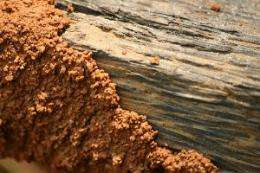Smart probe detects termites by 'hearing' them eat

Researchers at Edith Cowan University have come up with a sensitive acoustic device that can detect termite infestation by 鈥榟earing鈥� them chew through timber.
Once detected, the device can immediately send an SMS or email to a pest control firm -- with the termites鈥� GPS location -- so they can take appropriate action to protect the property.
The device can also detect termite activity in timber bridges and wooden power poles.
The developers are looking to commercialize the device in the next 12 months in Australia and say it has the potential to revolutionise the pest control industry.
The device is called WiSPr鈥攕hort for 鈥榳ireless smart probe鈥� network for acoustic detection.
Associate Professor Adam Osseiran said the technology consists of a tiny sensor鈥攎uch smaller than a fingernail鈥攚hich is attached to a piece of wood and placed around the house or retro-fitted to existing termite stations.
鈥淚t鈥檚 a wireless acoustic sensor that listens and recognises the acoustic 鈥榮ignature鈥� of termites chewing on your house,鈥� he says.
鈥淵ou would need about 20 devices placed every few metres around a house and they would be continuously listening and monitoring and providing an effective shield against termite attacks.鈥�
The market for termite control is huge.
鈥淚n Australia alone, there are 130,000 houses attacked by termites,鈥� A/Professor Osseiran says, 鈥渃ausing an estimated $1 billion to $3 billion dollars damage a year.鈥�
He says in the US, the yearly damage bill for termites tops $12 billion, and the main three markets for termite control are the US, Japan and Australia.
When placed in the ground, WiSPr can instantly detect termites or, if none are present, can serve as an early warning device if termites ever attack the property.
He says the device could also be used to detect termite activity in timber bridges and the hundreds of thousands of wooden electricity poles around Australia.
鈥淚f termites attack a pole, it could immediately send a signal to maintenance staff,鈥� he says.
鈥淥r by driving past bridges, council staff could 鈥榠nterrogate鈥� the device and find out about the health of the bridges, or poles, while they are driving.
鈥淭hat could be done by a smartphone application, which is something we are working on.鈥�
Provided by ScienceNetwork Western Australia

















